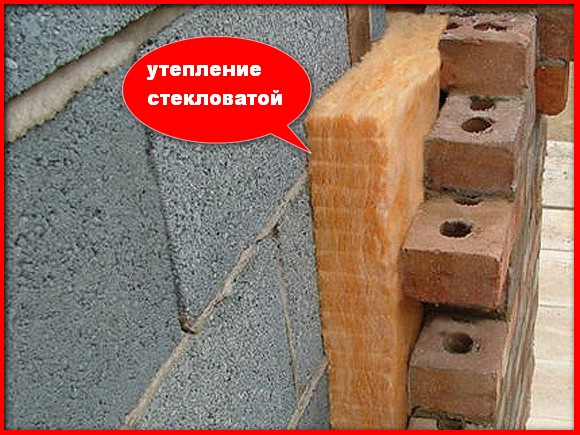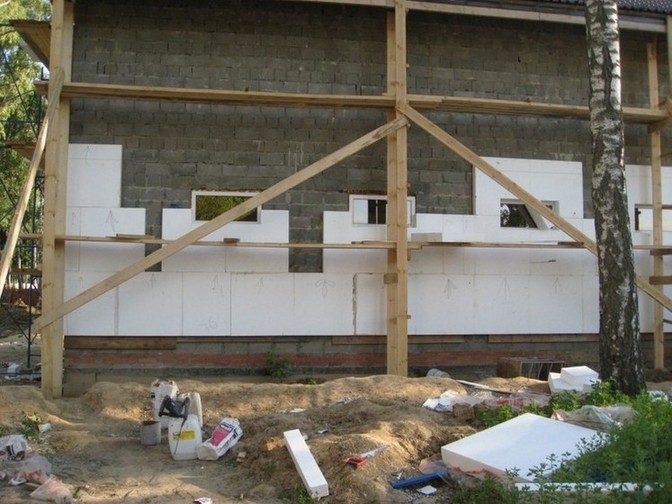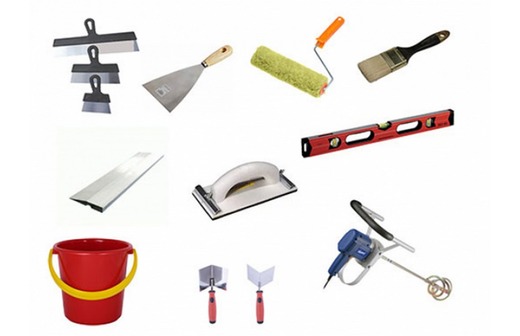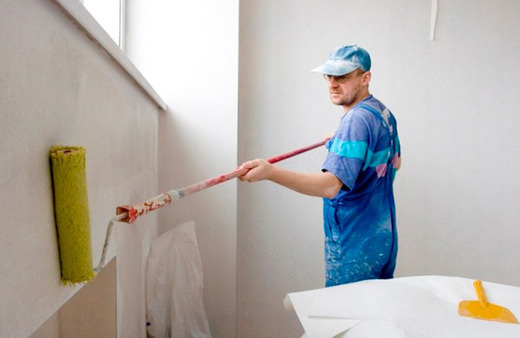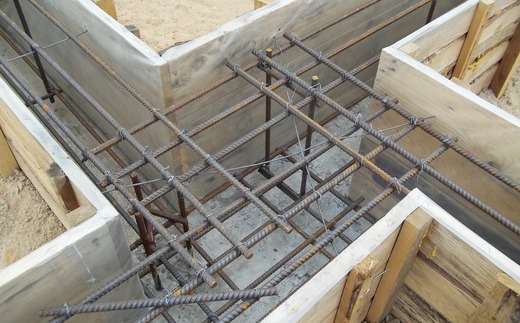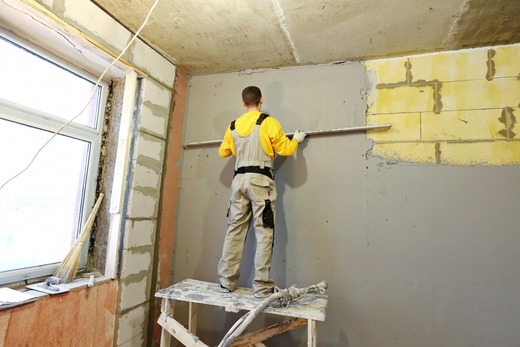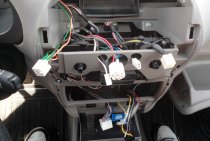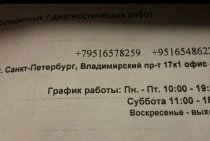material for insulation
Good thermal insulation of expanded clay blocks will be any insulation from the following list:
- Styrofoam;
- expanded polystyrene (penoplex);
- glass wool;
- mineral wool.
Glass wool is used traditionally and widely. It is not afraid of moisture, frost-resistant, retains air well. Its serious disadvantage is the environmental hazard. This is a heater that poses a serious health hazard during installation work or repairs. Unfortunately, builders do not consider this a disadvantage (unless it is their own home).
Mineral wool is similar to glass wool in many ways. It is also, like glass wool, an inorganic, resistant heat-shielding agent, with parameters close to it. mineral cotton is made from basalt or metallurgical slag. For health, mineral wool poses a lesser threat, since it does not form too thin and invisible fibers. Mineral (stone) wool is more expensive than glass wool.
Expanded polystyrene is close to polystyrene in terms of its heat-shielding properties, but it has an undoubted advantage over polystyrene - it is not afraid of rodents. Therefore, there are no additional costs for protecting the material from the access of these animals. At the same time, the cost of expanded polystyrene is higher than that of polystyrene.
Foam insulation
Use only special glue.
Instead of mineral wool, a material such as polystyrene foam can be used as a wall insulation for a house made of expanded clay concrete blocks. This option is less environmentally friendly, but it is quite inexpensive.
Wall insulation in a house made of expanded clay blocks is carried out according to the following technology:
The wall must be thoroughly cleaned of those substances that contribute to the deterioration of adhesion, these should include dust or oily liquid. After such a procedure is completed, it is necessary to determine the quality of the surface and its deviations. The next step is the primer. It should be borne in mind that if the surface is porous, it must be primed with 2 layers.
The next step is fixing the plates. On a pre-prepared base, you need to stick the foam. In order to do this, you need to use a special glue, it must be applied to the plate. Such glued plates must be fixed with special dowels, gaps remain between the insulation plates, they are filled with mounting foam.
The final stage of such a process is reinforcement. Reinforcing adhesive should be applied to the foam. This is done in 2 ways. There is a two-layer application: when the first layer of glue is applied, a reinforcing mesh must be pressed onto it, and then a second layer must be made. The adhesive is applied with a notched trowel, the mixture is spread with a notched trowel. After such application, the mesh will be easier to drown in glue.
If foam is used as a heater, then you should choose a type that has vapor permeability. You also need to take into account the fact that mice often settle in the foam. In order to avoid this, the foam can be concreted. If the walls are insulated with mineral wool, then the mice will never make holes there, no other living creatures will also be a serious cause for concern.
However, when using both materials, it is very important to make sure that birds cannot get inside the ventilated facade, otherwise all the heat-insulating material will be pecked. If for some reason it is not possible to use polystyrene foam as an insulating material, then polystyrene foam must be used.
This is also a type of foam, but it has higher qualities and thermal insulation.
Block wall insulation with materials such as polystyrene foam and mineral wool is one of the most common. These materials are lightweight, easy to install, inexpensive, and the functions of insulating the walls of the house are excellent.
It should be noted that it is recommended to insulate the house from the outside. The fact is that if you insulate the house from the inside, then the point of formation of water vapor is between the insulation layer and the wall material. This contributes to the formation of condensate, which leads to serious damage to the expanded clay blocks. In this regard, the insulation of walls from the outside has advantages, but from the inside they need to be well plastered, then there is no possibility of heat loss through the cracks in the masonry.
Thus, there is nothing complicated in this process. If you approach the matter thoroughly, with all diligence and care, there is no doubt that the result will be excellent.
Features of use
In order for the sheets of material to be securely held on a vertical surface, it is imperative to mount a wooden beam crate and a special frame system. The width of the crate to be installed, according to the norms, should be 2-3 centimeters less than the width of the cotton wool sheet. Also, anchors must be mounted in the wall - sheets of mineral wool will subsequently be put on them.

If the building is insulated with uneven expanded clay concrete walls, it is advisable to use mineral wool, which has two layers of different density. In this case, the material is attached to the wall with a soft layer so that it better adheres to the surface.
Features of buildings from foam blocks
A properly designed and built foam block house does not need additional insulation. The low coefficient of thermal conductivity of this building material provides effective protection of the house from heat loss. In general, it is worth considering the advantages inherent in buildings made of foam blocks:
- Moisture does not condense inside such a building material, which eliminates the appearance of fungi, mold and other microorganisms. This advantage is relevant only for a single-layer wall - in the case of foam concrete insulation, this advantage is lost.
- Homogeneous structure of foamed concrete prevents freezing of walls
- The cost of laying foam blocks is less than a similar building made of bricks
Obviously, all the technological features of this building material make it unnecessary to insulate the foam block.
This building material has the only drawback - low strength, but it can be eliminated without any special problems with the help of reinforcement.
Foam block house
The nuances of the work
There are 3 ways of external insulation of expanded clay concrete walls:
Ventilated façade. When choosing this method, a frame is first created, inside which insulation boards are laid
It is important to consider that the crate is attached to the wall, creating an additional load on it, so this method is not recommended.
Laying insulation between the block and facing bricks. This method is considered the most reliable and durable, but the cost of such a solution is high, and therefore not available to everyone.
"Wet" method
The budgetary method of external insulation, used most often. It consists in the fact that the insulation is fixed to the wall using a special solution, after which it is covered with a vapor barrier material, on top of which plaster is applied. The advantages of this option: the absence of a serious load on the wall, the ability to paint the facade of the building in any color, the low cost of materials and work, the protection of expanded clay concrete from the influence of external factors (precipitation, temperature changes, winds).
https://youtube.com/watch?v=KCL5RG-AIeY
Possible situations
It is easy to insulate a house from expanded clay concrete from the outside, knowing the two main options for laying expanded clay concrete block
It is important to study each in order to choose the best one for your home.
External façade cladding missing
This means that there is nothing but two rows of expanded clay concrete blocks. Facade materials outside are completely absent. In such a situation, facing the building with bricks, it is possible to place a heater between the lining and expanded clay concrete.
This is an effective thermal insulation measure, but it is rarely used. And all because the material for facing the whole house will be expensive. In addition, it is difficult to do such a volume of work on insulation with this material. Because of this, you have to resort to outside help, which is also worth the additional cost.
More budget options for insulation are made using panels. For example, lining, metal or plastic siding. Styrofoam often acts as a heater in such situations. This material is laid in two layers, provided that it is 5 cm thick. The panels are placed on expanded clay concrete so that the seams of the first layer do not converge with the second. Next, the siding is laid, and a vertical profile is placed under it, which forms the frame.
In addition to foam panels, mineral or basalt wool is used. But such materials require protection in the form of a vapor barrier. A glued slab heat-insulating layer is also used, and then covered with plaster. Plate insulation - polystyrene foam, polystyrene foam or polystyrene foam. Easily attached to expanded clay concrete, and then fixed with dowels.
Facade with facing bricks
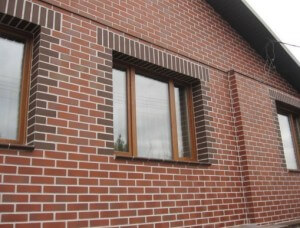
With such insulation, the expanded clay house is protected from moisture, rodents, and mold. The only disadvantage of this procedure is the price. In addition, specialists are needed to deposit this material, which also entails additional costs.
The procedure for work with insulation
To independently insulate expanded clay walls, you should strictly adhere to the technology of work. The process consists of several stages: surface preparation, preparation of the mortar, application of the adhesive composition on the boards, installation of insulation, creation of a vapor barrier layer, reinforcement, and cladding.
Materials and tools
For work you will need:
- insulation;
- fiberglass facade mesh;
- primer;
- adhesive composition for insulation;
- putty;
- drill with a nozzle for mixing the solution;
- containers for the preparation of glue and putty;
- cuvette and brush for applying a primer;
- construction level;
- spatulas - narrow, wide, serrated;
- dowels are umbrella-shaped;
- construction knife;
- mounting foam;
- roulette;
- vapor barrier material (membrane);
- construction tape.
Depending on which cladding method is chosen, other materials will also be needed: brick, siding or facade plaster.
Training
The surface is cleaned of debris, dust, dirt. Apply a layer of primer, wait until it dries, proceed to the application of plaster. The wall is primed again to ensure high-quality adhesion of the insulation to the surface.
The next step in the process of insulating walls from expanded clay blocks is the preparation of a solution
Today, a large number of adhesive compositions are produced, and when choosing, you should pay attention that it is suitable for the selected insulation. The solution is prepared, focusing on the instructions on the package.
Application of the composition and installation of plates
The adhesive must be applied using a notched trowel, distributing a thin layer over the entire surface of the wall. There should be no empty lots. After that, the composition is applied to the plate itself - around the perimeter and in the center.
Installation starts from the bottom of the wall, go sequentially around the perimeter of the building. With this method, all the plates in the first row will have time to be firmly fixed, and the load from those installed above will not move them. The evenness of the position of each plate is checked using the building level. The second and subsequent rows are performed with a shift of half the length of the plate. To do this, cut the slab in half using a construction knife.
Additional fixing and installation of vapor barrier
After the adhesive solution has hardened (about a day later), the insulation is additionally fixed to the expanded clay concrete with dowels. They are driven in along the perimeter of the plates and in the center.
When using mineral or basalt wool, a vapor barrier layer is required to protect the material from getting wet. For this purpose, special membrane films are used, which also protect from the wind. The film is fixed by placing the strips vertically. In this case, each next strip should overlap the previous one by at least 10 cm. The joints are glued with construction tape.
Reinforcement
Proceed to the installation of reinforcing mesh. It is attached vertically. Using a tape measure, measure the height of the wall, cut off a piece of mesh of the desired length. Apply plaster to the area of \u200b\u200bthe insulation, press the mesh into it. This must be done quickly before the plaster has hardened. In order to level the surface of the plaster at the same time as pressing the mesh, it is recommended to use a facade spatula for work.
Finishing
Cladding after the insulation of expanded clay walls can be done using brickwork, installing siding or using plaster.
The wall is plastered after the composition layer on which the reinforcing mesh is fixed has completely dried out. After that, the surface is primed again, they wait until the wall dries, then they start applying the starting and finishing compositions. The final stage is painting the facade.
The second option is to install siding. In this case, the reinforcing mesh is not required, the cladding is installed directly on the slabs. Since the "wet" method does not require the installation of battens, the installation of siding will require the installation of anchors on which the slats will be attached.
It is necessary to insulate the walls of a building built of expanded clay concrete blocks - this not only reduces heat loss, but also lengthens the life of the house. The cost of the materials that will be required is affordable, and the work itself is quite possible to carry out on its own.
The cost of materials and work
Budgeting is an inevitable part of any construction or renovation project.
| Type of finishing work | Work (per 1 sq.m) | Material (per 1 sq.m) | |
|---|---|---|---|
| 1 | Wall preparation (plaster) | 400 | 60 |
| 2 | Wall preparation (primer) | 80 | 60 |
| 3 | Glue for insulation | 20 | 80 |
| 4 | Insulation (glass wool) | 500 | 1500 |
| 5 | Insulation (stone wool) | 400 | 2300 |
| 6 | Insulation (polystyrene) | 100 | 150 |
| 7 | Insulation (polystyrene foam) | 80 | 200 |
| 8 | Moisture and wind protection (film) | 10 | 20 |
| 9 | Insulation fixture | 150 | 150 |
| 10 | Siding (plastic) | 100 | 40 |
| 11 | Foundation for brick cladding | 300 | 2000 |
| 12 | Laying in half a brick | 800 | 700 |
According to these data, you can estimate the cost of one square meter of decoration and then the whole house as a whole. Suppose there is a house measuring 6x8 m, with a wall height of 3 m, and its owner decided to make foam insulation with a final finish with vinyl siding.
One square meter of the "package" will cost 1420 rubles:
| Pos. | Cost of work | Cost of materials |
|---|---|---|
| 1 | 400 | 60 |
| 2 | 80 | 60 |
| 3 | 20 | 80 |
| 6 | 100 | 150 |
| 8 | 10 | 20 |
| 9 | 150 | 150 |
| 10 | 100 | 40 |
| Total: | 860 | 560 |
We multiply the result by the area to be finished, and we get: 72240 + 47040 = 119280 rubles. The reserve of savings here is that the owner can perform part of the work on his own, anyway, you will have to pay for the materials.
How to insulate a foam block house from the outside
By choosing to insulate the house from the cinder block from the outside, the homeowner receives the following benefits:
- The useful area is preserved in the rooms. If decorative finishing has already been done in the premises, then it is even more impractical to insulate the building from the inside.
- The absence of obstacles for warming up the house from the inside.
- In the presence of internal thermal insulation, foam concrete blocks are cyclically heated and frozen, which negatively affects the integrity of their internal structure.
- The presence of insulation inside living rooms shifts the dew point to the premises, which causes moisture condensation in the thickness of the wall. This provokes the development of mold fungi and the destruction of the material.
- When performing external insulation, the dew point moves closer to the outer surface of the building. So the blocks do not accumulate moisture - on the contrary, it constantly evaporates due to the ventilation gap.
How to insulate a foam block with foam plastic from the outside
For external insulation of the facade with foam, the following steps must be performed:
- Remove all contaminants and irregularities from the wall.
- We apply a primer layer, which will prevent the penetration of glue into the thickness of the wall. The primer layer is a significant consumption of glue, which ultimately has a positive effect on the cost of work.
- Fasten a metal profile to the wall, on which the first row of foam will be mounted.
- In accordance with the instructions, you need to prepare a homogeneous glue - it is best to use an ordinary drill with nozzles for mixing.
- We glue the insulation, laying out the plates in a checkerboard pattern.
- We fix the foam sheets with dish-type dowels. Each plate must be fixed at the edges and the central part
- We fix the reinforcing network - this layer will increase the strength of the insulating material.
- The wall is covered with plaster, finishing - facade putty, as an option, you can choose siding or other finishes
Insulation of the walls of the house with foam
Insulation of the foam block with foam plastic from the outside
To insulate a foam block house from the outside with foam, you should follow these steps:
- Cleaning the wall of the house - we get rid of dirt, dust, old mortar.
- We apply a layer of primer to increase the adhesion of the adhesive.
- We fix the basement profile located at the bottom of the wall - it will play the role of a support for the insulation, and will also become an obstacle for rodents.
- Mixing glue with a drill
- The glue is applied to the insulation boards, which are glued to the wall from the bottom up. Each subsequent layer is shifted relative to the previous one by half the length of the insulation plate.
- Additionally, we fix the insulation with fungi - the dowels are installed in the corners and in the center.
- Gluing a reinforcing mesh that provides the necessary rigidity to the insulating layer.
- Finishing stage - close the grid with plaster, and then paint the facade.
Foam block insulation with mineral wool
Mineral heaters have shown themselves well to improve the thermal insulation of a house made of foam blocks. All this can be done with your own hands:
- The preparatory stage, at which the wall is cleaned of all unnecessary elements, whether it be dust, dirt, mortar drips, and so on. If necessary, the walls are leveled.
- Waterproofing film that protects mineral wool from moisture.
- Fastening the starting profile at the bottom of the wall - it is necessary to support the thermal insulation material.
- Mounting on the facade of wooden rails, between which mineral wool will be located.
- Sliced pieces of mineral wool are inserted into the crate.
- Laying a vapor barrier membrane, alternatively, the membrane can be superdiffusion.
- We fasten planks of wood with a thickness of 20-30 mm over the membrane - they are necessary to form a ventilation gap.
- On top of the crate, we sheathe the wall with siding, you can use PVC panels.
Insulation of the house from the inside
Experts say that warming the house from the inside is not a prudent decision.Condensation may occur on the walls due to the shift in the dew point, in addition to this, the walls freeze through.
Therefore, for internal insulation in houses, dense materials are used that have a vapor barrier. Gypsum or cement plaster will help protect and insulate the wall from the inside. The mass of gypsum mortar is less, and the possibility of saving heat is higher. The only negative is that gypsum does not adhere well to expanded clay concrete blocks. To eliminate this drawback, you need to prepare the wall before work.
The next issue after construction, which needs to be considered at the design stage, is the insulation of the house, it will greatly help reduce heating costs. Next, we will consider the need for insulation of walls built of expanded clay concrete, and also list the materials that can be used for thermal insulation of walls from the outside.
